Why are my hot tub jets weak?: Diagnose and Fix
Are your hot tub jets not giving you the relaxing experience you were hoping for? Whether they’re barely pushing out water, only working on one side, or sputtering after a refill, these problems can turn what should be a soothing soak into a frustrating chore. I get it—dealing with these issues isn’t fun, especially when all you want is to unwind.
In this guide, we’ll go over some common reasons why your hot tub jets might not be working properly and offer simple, practical solutions to help you fix them.
Whether you’re facing clogged jets, airlocks, or something more complex, I’m here to walk you through it. Let’s get your hot tub running smoothly again, so you can get back to enjoying that well-deserved relaxation.
How Do Hot Tub Jets Work?
Hot tub jets are designed to provide a soothing and therapeutic experience by combining water pressure, air, and heat. Understanding how they function can help you maintain your hot tub and troubleshoot any issues that arise.
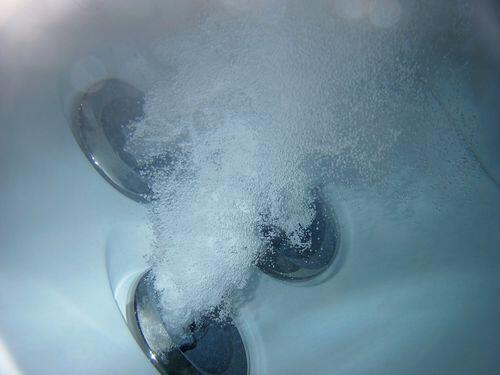
Overview of Jet Functionality
Operate through a coordinated system involving the pump, heater, and air injectors. The pump draws water from the tub, sending it through filters and the heater before pushing it out through the jets. As the water passes through the jets, air is introduced into the stream via air injectors, creating a powerful, massaging effect.
The combination of heated water and pressurized air provides the hydrotherapy that hot tubs are known for, helping to relieve muscle tension and stress.
Common Jet Types
Each type of jet plays a role in delivering a full-body hydrotherapy experience, making your time in the hot tub both relaxing and therapeutic.
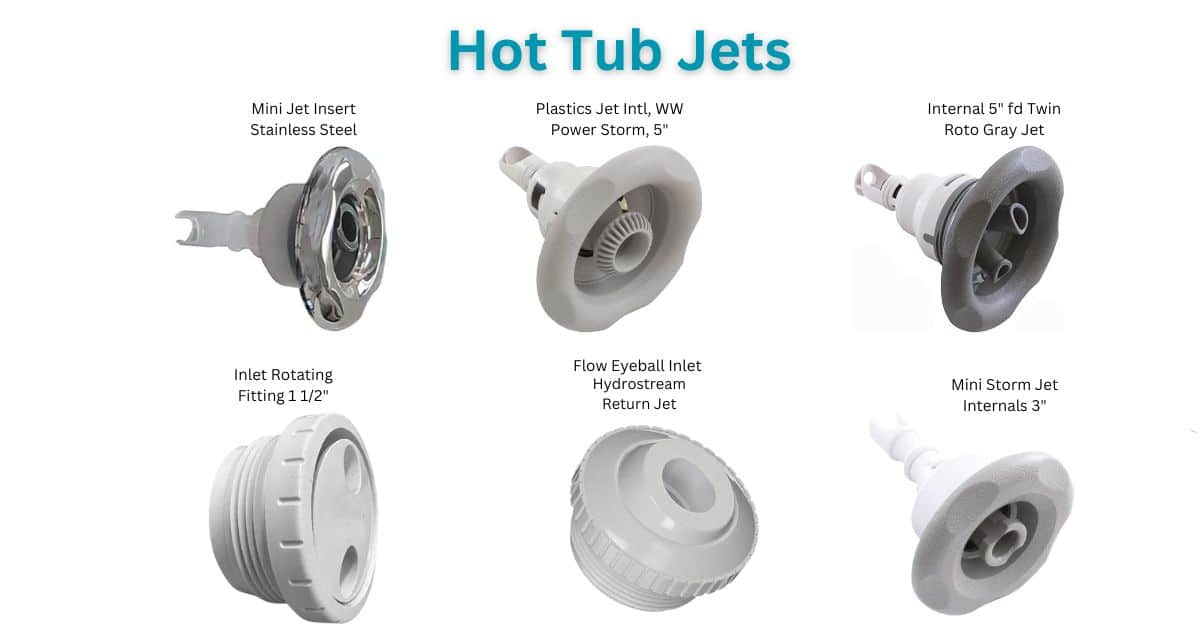
- Directional Jets: These jets allow you to adjust the direction of the water flow, targeting specific areas of the body for a customized massage experience.
- Rotary Jets: Rotary jets create a rotating stream of water, offering a broader and more dynamic massage that covers a larger area of the body.
- Footwell Jets: Located at the bottom of the hot tub, footwell jets are designed to massage the feet and legs, providing relief to often-overlooked areas.
Signs and Symptoms of Hot Tub Jet Problems
By recognizing these signs and understanding the potential causes, you can take the necessary steps to diagnose and fix your hot tub jet problems, ensuring a smooth and enjoyable spa experience.
Weak Jets
If your hot tub jets are weak, it’s usually a sign that something is obstructing the water flow or reducing the pressure. Common causes include:
- Clogged Filters: Dirty or clogged filters can restrict water flow, leading to reduced jet pressure.
- Airlocks: Air trapped in the plumbing lines can prevent water from flowing properly, resulting in weak jets.
- Worn or Loose Jets: Over time, jets can wear out or become loose, which diminishes their ability to create strong water pressure.
- Calcium Build-Up: High levels of calcium in the water can lead to deposits in the pipes, blocking water flow and reducing pressure.
Jets Not Working on One Side
When jets on only one side of the hot tub stop working, it could indicate a more localized problem:
- Diverter Valve Issues: A malfunctioning or improperly positioned diverter valve, which controls the flow of water to different areas of the hot tub, can cause jets on one side to lose pressure or stop working altogether.
- Obstructions in the Plumbing: Debris or blockages in the plumbing lines leading to one side of the hot tub can result in those jets not functioning properly.
- Pump Problems: If the pump isn’t working efficiently or if there is an issue with the plumbing connected to one side, it could result in some jets working while others do not.
Sputtering Jets in In-Ground Hot Tubs
Sputtering jets are a common issue in in-ground hot tubs and are often related to air getting into the system:
- Air in the Lines: Air can enter the plumbing lines during maintenance, refilling, or due to leaks. When air mixes with the water, it causes sputtering as the jets struggle to maintain a steady flow.
- Low Water Levels: If the water level in the hot tub is too low, air can be drawn into the system, leading to sputtering jets.
- Plumbing Leaks: Small leaks in the plumbing can also introduce air into the system, causing an uneven flow and sputtering.
Diagnosing the Problem
By methodically checking these components, you can identify the root cause of your hot tub jet issues and take the appropriate steps to fix them, restoring your spa to its full relaxing potential.
Is the Pump Working Properly?
The pump is the heart of your hot tub’s jet system. If it’s not working correctly, the jets won’t have the pressure they need to function. Start by listening for unusual noises, like loud humming or grinding, which could indicate a mechanical issue. Ensure the pump is receiving power and operating as it should. If the pump isn’t running smoothly, it might be due to a faulty motor, electrical issues, or blockages in the system.
Dirty or Clogged Filters?
Filters play a critical role in maintaining water flow. Over time, they can become clogged with debris, oils, and minerals, restricting the water supply to the jets. To check the filters, first, turn off the power to the hot tub. Remove the filters from their housing and inspect them for visible dirt and blockages.
If they look dirty, clean them thoroughly by rinsing them with a garden hose or soaking them in a filter cleaning solution. Remember, some filters might need to be replaced rather than cleaned, especially if they are worn or damaged.
Low Water Levels?
Low water levels can cause air to be drawn into the plumbing lines, leading to weak or sputtering jets. To avoid this, regularly check that the water level in your hot tub is above the minimum fill line, usually marked on the tub’s inner wall. If the water level is low, simply add more water until it reaches the appropriate level. Keeping the water at the right height ensures that the pump can circulate water efficiently without pulling in air.
Clogged Drain Cover or Jet?
Blockages in the drain cover or jets can severely impact water flow. To inspect, turn off the power and remove the drain cover to check for debris, such as leaves or dirt, that might be obstructing the water intake. Similarly, check each jet for blockages.
You can clean the jets by using a small brush to remove any debris or by soaking them in a vinegar solution to dissolve mineral build-up. Ensuring that the drain cover and jets are clear of obstructions will help maintain proper water flow and jet pressure.
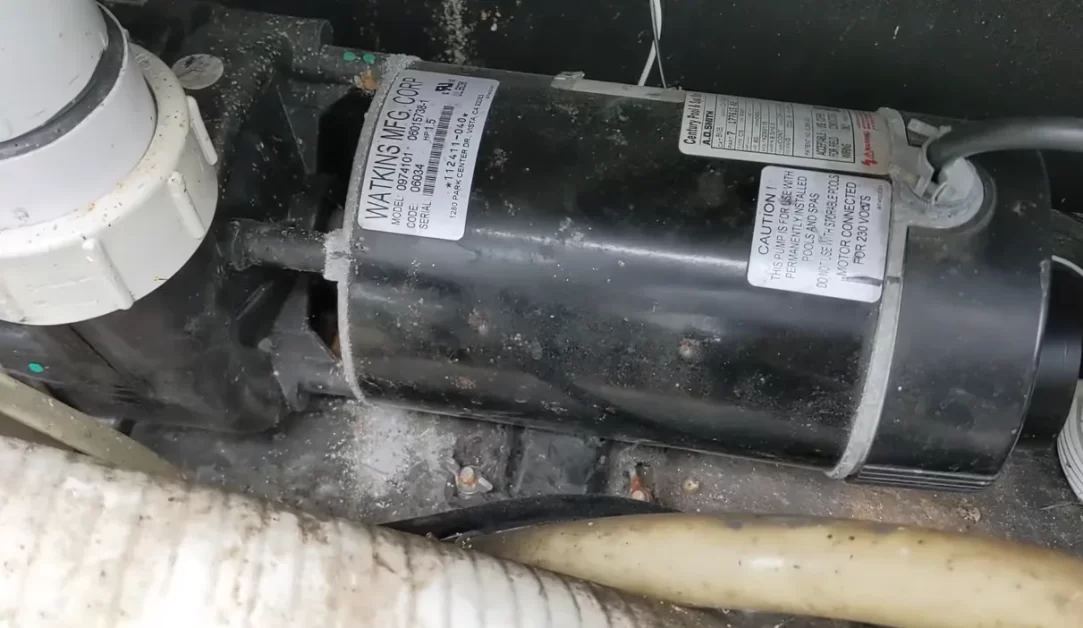
How to Fix Weak Hot Tub Jets
By following these steps, you should be able to restore the strength of your hot tub jets and enjoy a more relaxing soak. If these solutions don’t work, it might be time to consult a professional for further assistance.
Common Causes of Weak Jets
- Clogged Jets: Dust, debris, and mineral deposits can accumulate over time, blocking the water flow.
- Loose Jets: Jets can become loose, reducing the pressure they generate.
- Calcium Build-Up: High calcium levels can cause build-up in the pipes, restricting water flow.
- Airlock: Air trapped in the plumbing lines can prevent the pump from pushing water effectively.
Steps to Increase Jet Pressure
- Check and Adjust Pressure Settings: Some hot tubs have adjustable pressure settings. Ensure that the jets are set to the desired pressure level.
- Tighten Loose Jets: If the jets are loose, give them a slight twist to secure them. This might improve the water pressure.
- Clean the Jets: Remove any debris or calcium deposits from the jets. Soaking them in a vinegar solution can help dissolve mineral build-up.
- Address Airlock Issues: If you suspect an airlock, you can release the trapped air by loosening the barrel union slightly until water begins to flow out, then tighten it back up.

When to Replace Jets
If the jets are worn out or heavily clogged, cleaning might not be enough. In such cases, replacing the jets is the best solution to restore your spa’s performance.
| Problem | Potential Solution |
|---|---|
| Clogged Jets | Clean or replace the jets |
| Loose Jets | Tighten the jets |
| Calcium Build-Up | Use a descaler to clean the pipes |
| Airlock | Release trapped air from the system |
Addressing Specific Issues with Hot Tub Jets
By addressing these specific issues methodically, you can restore your hot tub jets to full functionality and continue enjoying a relaxing soak without interruptions.
Jets Not Working After Refill
Refilling your hot tub should be a straightforward process, but sometimes it can lead to issues like jets not working properly afterward. The most common culprit is an airlock, which occurs when air gets trapped in the plumbing lines during the refill process. This trapped air prevents water from flowing through the jets.
How to Fix Airlocks:
- Turn Off the Pump: Start by turning off the pump to avoid damage.
- Release the Air: Locate the barrel union on the pump and slightly loosen it to allow air to escape. You should hear a hissing sound as the air is released. Once water starts to leak out, tighten the union back up.
- Restart the Pump: Turn the pump back on and check if the jets are now functioning properly. Repeat the process if necessary until the jets operate normally.
Air Lock Symptoms and Solutions
An airlock can cause a range of issues, from weak jet pressure to completely non-functioning jets. Identifying the symptoms early can save you from prolonged problems.
Symptoms of an Airlock:
- Weak or No Water Flow: The most common sign is weak water flow or no flow at all from the jets.
- Noisy Pump: You might hear gurgling or sputtering sounds coming from the pump.
- Bubbles in Water: Air bubbles coming out of the jets can indicate that air is trapped in the system.
How to Remove an Airlock:
- Cycle the Jets: Turn the jets on and off several times, switching between high and low settings to force the air out of the lines.
- Manual Air Release: If cycling doesn’t work, manually release the air by loosening the barrel union as described above.
- Check Water Levels: Ensure the hot tub is filled to the correct level to prevent air from being drawn into the system.
Half the Jets Not Working
If only half of the jets in your hot tub are working, it can be due to a few potential issues, often related to the water flow distribution or a blockage.
Possible Causes:
- Diverter Valve Issues: The diverter valve, which controls the flow of water to different sections of the hot tub, might be malfunctioning or partially closed.
- Partial Blockages: Debris or build-up in the plumbing could restrict water flow to certain jets, causing only some to work.
How to Correct It:
- Check the Diverter Valve: Ensure the diverter valve is fully open and functioning properly. Adjust it to see if this restores flow to all jets.
- Inspect for Blockages: Remove and inspect the jets that aren’t working. Clean them thoroughly or replace them if they’re heavily clogged or damaged.
How to Unblock Spa Jets
By using these methods, you can effectively unblock your spa jets, ensuring they provide the strong, consistent flow needed for an enjoyable hot tub experience.
Simple Cleaning Techniques
One of the easiest ways to unblock spa jets is by using a dedicated hot tub jet cleaner. These products are specifically designed to dissolve and remove the buildup of minerals, oils, and other debris that can clog the jets.
Steps to Clean Jets with a Hot Tub Jet Cleaner:
- Turn Off the Hot Tub: Before starting, make sure the hot tub is turned off to avoid any accidents.
- Apply the Cleaner: Follow the instructions on your hot tub jet cleaner product. Typically, you’ll add the cleaner directly to the water or spray it onto the jets.
- Run the Jets: Turn the jets on for the recommended amount of time (usually 15-20 minutes) to allow the cleaner to circulate and break down the buildup.
- Rinse and Refill: After cleaning, drain the hot tub, rinse it thoroughly with fresh water, and then refill it to the appropriate level.
DIY Methods
If you prefer a more natural approach or don’t have a commercial cleaner on hand, you can use simple home remedies like vinegar to unblock your spa jets. Vinegar is effective at breaking down mineral deposits and is a safe, non-toxic option. Check out Using Vinegar And Baking Soda In Hot Tub.
How to Clean Jets with Vinegar:
- Prepare a Vinegar Solution: Mix equal parts of white vinegar and water in a large container.
- Remove the Jets: Carefully remove the jets from the hot tub, following the manufacturer’s instructions.
- Soak the Jets: Submerge the jets in the vinegar solution for 3-4 hours to dissolve any buildup inside the jets.
- Brush and Rinse: After soaking, use a soft brush to scrub away any remaining debris. Rinse the jets thoroughly with water.
- Reinstall the Jets: Once clean, reinstall the jets in your hot tub and check if the water flow has improved.
Hot Tub Jet Replacement and Maintenance
Sometimes, despite regular maintenance, jets may wear out or become damaged and need replacement. Here’s how to know when it’s time to replace your jets, how to do it, and whether upgrading them is a viable option.
When to Replace a Hot Tub Jet
Over time, hot tub jets can deteriorate due to regular use, chemical exposure, or calcium buildup. Recognizing the signs that a jet needs replacing can prevent further issues and maintain your hot tub’s performance.
Signs That a Jet Needs Replacing:
- Visible Damage: Cracks, chips, or significant wear on the jet face or body indicate it’s time for a replacement.
- Persistent Clogging: If cleaning doesn’t restore proper function, the jet might be too clogged or damaged internally to continue using effectively.
- Loose or Unsteady Jets: Jets that no longer stay securely in place, even after tightening, often need replacement.
- Reduced Water Pressure: If a specific jet is consistently weaker than others despite troubleshooting, it may be worn out.
Identifying Compatible Replacement Jets:
- Match the Model: Check your hot tub’s manual or the manufacturer’s website for compatible jet models.
- Measure the Jet: If you don’t have the model number, measure the diameter of the jet and compare it with available replacements.
- Consult with a Professional: If unsure, contacting a hot tub specialist can help ensure you get the correct replacement.
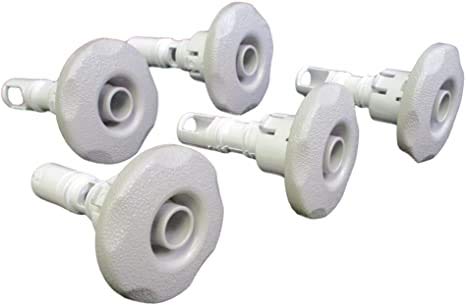
How to Replace Hot Tub Jets
Replacing a hot tub jet is generally a straightforward process that you can do yourself with a few basic tools.
Step-by-Step Guide to Replacing Old or Broken Jets:
- Turn Off the Power: Always start by turning off the hot tub to avoid any electrical hazards.
- Remove the Old Jet: Twist the old jet counterclockwise to unscrew it from the socket. If it’s stuck, use a rubber strap wrench for extra grip.
- Inspect the Socket: Check the jet socket for any debris or damage. Clean it out if necessary to ensure a good fit for the new jet.
- Install the New Jet: Align the new jet with the socket and twist it clockwise until it’s securely in place. Ensure it’s properly seated and not loose.
- Test the Jet: Turn the power back on and run the jets to ensure the new one is working correctly and there are no leaks.
Can I Upgrade My Hot Tub Jets?
Upgrading your hot tub jets can enhance your spa experience by providing more powerful or targeted hydrotherapy. However, it’s important to consider a few factors before making any changes.
Options and Considerations for Upgrading Jets:
- Compatibility: Not all hot tubs are designed to accommodate upgraded jets. Check with the manufacturer to see if your model supports more advanced jets.
- Pump Capacity: More powerful jets may require a stronger pump. Ensure your current pump can handle the increased demand without overworking.
- Jet Variety: Upgrading gives you access to different types of jets, such as pulsating or multi-directional jets, that can offer a more customized massage experience.
- Professional Installation: For complex upgrades, especially those requiring pump adjustments, it might be best to consult a professional to ensure the installation is done correctly. Check out hot tub accessories.
FAQs: (hot tub jets weak)
Q: How do I make my hot tub jets stronger? There are two ways to do this: 1. Increase the flow to the jets by increasing the pump speed. 2. Increase the pressure of the water being fed to the jets by using a booster pump (if your spa has one) or an additional pump if necessary.
Q: Why are my hot tub jets not as powerful? The most common reason for this is that the water level in your spa has dropped, causing a loss of hydrostatic pressure. It must be closed if you have a side drain or an overflow.
Q: Why are my hot tub jets too powerful? There are one of two reasons for this. The first reason is that the water level in your spa has dropped, causing a loss of hydrostatic pressure. It must be closed if you have a side drain or an overflow.
Q: What is the difference between a jet pump and a circulation pump? The jet pump operates at a lower pressure and is used for water features such as fountains. It is less potent than the circulation pump but works well with smaller hot tubs.
If you’re unsure about any part of the process or need quality replacement parts, visit Hot Tub Patio for expert advice and a wide selection of hot tub products. Ready to enhance your spa experience? Explore our offerings today!
What’s the biggest challenge you’ve faced with your hot tub jets? Let us know in the comments below!







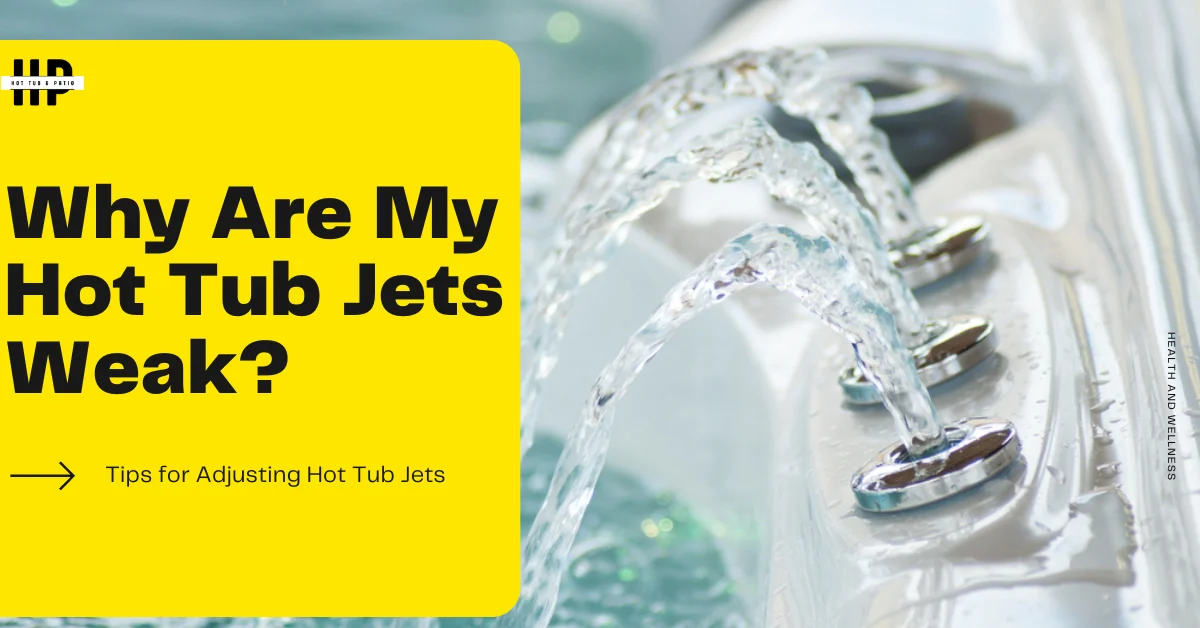

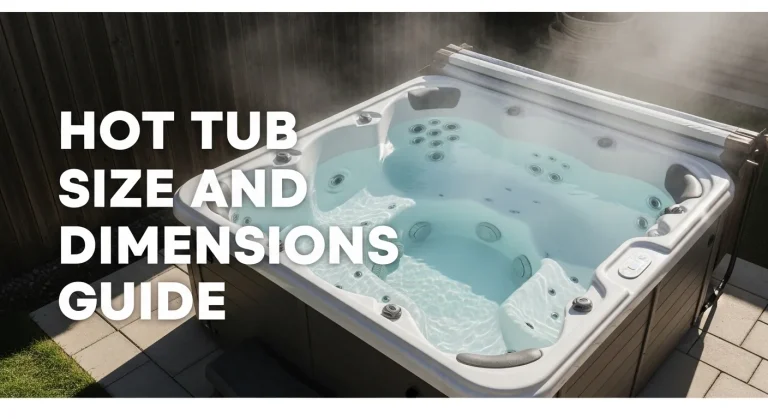

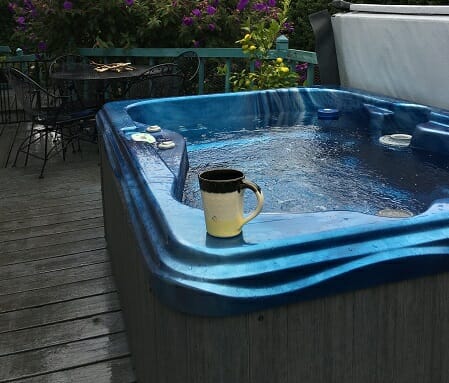

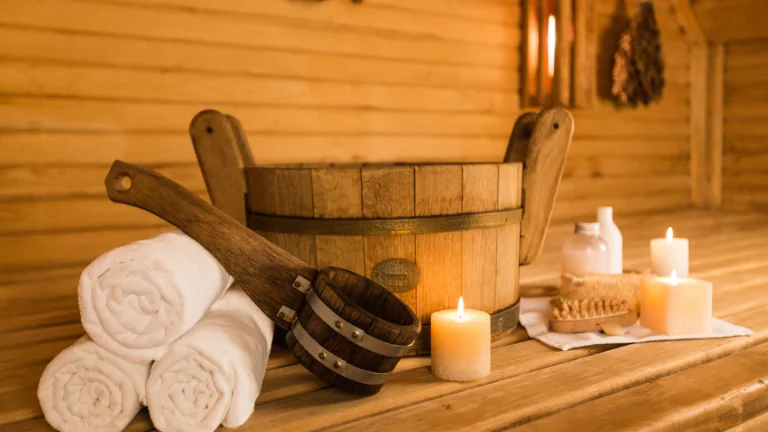
One Comment